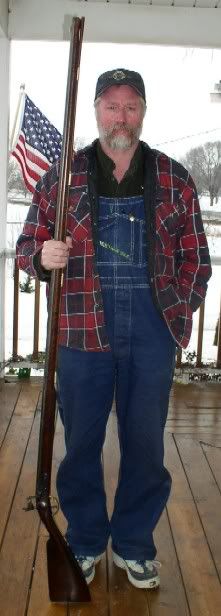paulvallandigham
Passed On
- Joined
- Jan 9, 2006
- Messages
- 17,537
- Reaction score
- 89
Verdigris: If you are insisting on a pre-1760 style fowler, you are going to have to use a bore size larger than 20 gauge. 14, 12, 10, and even 8 bores were the order of the day for reasons already stated. Only you can decide how long a barrel you want on your gun. If this is going to sit in a display case, then maybe one of those 6 foot long barrels that Mike Brooks likes would be just the ticket for you. If you really are going to trek with it, You might want to keep the length of the barrel down to something reasonable. Depending on gauge you choose, the balance of the fowler becomes the most critical, in deciding barrel length. It also depends if you are trying to replicate some kind of military role, or simply be a country gentleman, out hunting whatever he might find. The longer barreled guns were used by the gentlemen, primarily because they could afford them. Working class men bought what they could afford, and tended to use shorter barrels. Canoe guns might have barrels as short at 24 inches, although 30"" and 36" are and were common.
I had the chance to examine and handle an original DB 12 gauge shotgun made in the Tower Armory in London, dated 1778, I believe, that had 36 inch barrels. At the time, there were only two or three long rifles in my gun club with barrels that long or longer, and no one had a shotgun with 36" barrels! I was suspecting it to be terribly muzzle heavy, but in fact, it was balanced between the hands, and handled as well as any modern made, high grade double I have ever shot.
You are trying to replicate a gun used 40 years or so before that example was made, so I suspect that you might prefer a barrel that is 42 or 44" long. Its really going to depend on how thick the barrel is at the muzzle, and how much the buttplate weighs, to provide a counterbalance. The buttplate on that Tower shotgun was nearly 3 inches wide, and made of thick brass. Its weight no doubt contributed to the fine balance of the gun.
I had the chance to examine and handle an original DB 12 gauge shotgun made in the Tower Armory in London, dated 1778, I believe, that had 36 inch barrels. At the time, there were only two or three long rifles in my gun club with barrels that long or longer, and no one had a shotgun with 36" barrels! I was suspecting it to be terribly muzzle heavy, but in fact, it was balanced between the hands, and handled as well as any modern made, high grade double I have ever shot.
You are trying to replicate a gun used 40 years or so before that example was made, so I suspect that you might prefer a barrel that is 42 or 44" long. Its really going to depend on how thick the barrel is at the muzzle, and how much the buttplate weighs, to provide a counterbalance. The buttplate on that Tower shotgun was nearly 3 inches wide, and made of thick brass. Its weight no doubt contributed to the fine balance of the gun.







